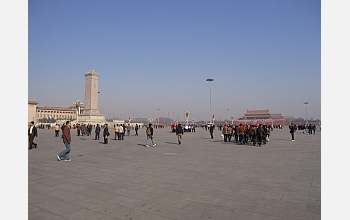News Release 06-080
Pollution, Greenhouse Gases and Climate Clash in South Asia
Pollution clouds in region appear to lead to drought and other impacts

This photo from Beijing, China, shows urban pollution haze.
May 11, 2006
This material is available primarily for archival purposes. Telephone numbers or other contact information may be out of date; please see current contact information at media contacts.
A new analysis by atmospheric scientists shows how air pollution, global climate change-producing gases and natural fluctuations in climate impact the world's most populous regions.
In a study published in the May 15, 2006, issue of the Journal of Climate, published by the American Meteorological Society (AMS), scientists Chul Eddy Chung and V. Ramanathan of the Scripps Institution of Oceanography describe their analysis of sea-surface temperatures and other data from the Indian Ocean region.
They found that cooler-than-normal temperatures in the northern part of the ocean have weakened the natural climate circulation and monsoon conditions in the region, resulting in reduced rainfall over India and increased rainfall over the Sahel area south of the Sahara in Africa.
As the tropical Indian Ocean heats up due to climate change, the authors say, the northern Indian Ocean, which is adjacent to highly populated regions, is not warming as quickly as the rest of the ocean, resulting in increased drought conditions that could have repercussions for more than 2 billion people in South Asia. These conditions impact a range of industries and resources, from agriculture to freshwater availability.
The culprit behind the changes, the authors argue, is an ongoing and intricate clash between air pollution, greenhouse gases and naturally produced climate changes.
In previous studies, they explain, they and an international group of colleagues had found that pollution particles called aerosols are "masking" warming effects from greenhouse gases.
Likewise in the current study, says Ramanathan, director of the Center for Clouds, Chemistry and Climate at Scripps. "It appears that this whole tropical area is being pulled in different directions. The greenhouse gases are pushing in one direction, warming the ocean and trying to make more rain, and the aerosols are pushing in another direction, toward a cooler ocean and less rain. The net effect is to drive the monsoon rain system away from South Asia into the equatorial and southern oceans."
"Some years the aerosols might win, and some years the greenhouse effect may win," Ramanathan says. "We're concerned that in coming decades the variability between the two will become large and it will be difficult to cope with rapid changes from year to year."
"This study is a demonstration that Earth's climate hangs in delicate balance between natural and man-made forces," says Jay Fein, director of the National Science Foundation (NSF)'s climate dynamics program, which, along with NASA, funded the research. "Understanding the processes that can throw climate out of balance is among the most challenging issues facing us today."
In addition to Asia, similar pollution, or brown haze, clouds, can be seen in various regions around the world, including over major urban locations such as Los Angeles and Denver in the United States.
Some five to 10 years ago scientists thought about pollution as solely an urban problem, said Ramanathan. "Now we have discovered that these pollution clouds travel quickly and can cover an entire ocean."
Scientists have shown that in a matter of five days, airborne pollutants can travel from China to the United States, and in a matter of three to four days, they can travel from the United States to Europe.
-NSF-
-
Haze obscures many urban areas, like Frankfurt, Germany.
Credit and Larger Version -
Pollution haze hangs above Los Angeles.
Credit and Larger Version
Media Contacts
Cheryl Dybas, NSF, (703) 292-7734, email: cdybas@nsf.gov
Mario Aguilera, SIO/UCSD, (858) 534-3624, email: maguilera@ucsd.edu
Stephanie Kenitzer, AMS/Journal of Climate, (425) 432-2192, email: kenitzer@dc.ametsoc.org
Related Websites
Center for Clouds, Chemistry & Climate: http://www-c4.ucsd.edu/
The U.S. National Science Foundation propels the nation forward by advancing fundamental research in all fields of science and engineering. NSF supports research and people by providing facilities, instruments and funding to support their ingenuity and sustain the U.S. as a global leader in research and innovation. With a fiscal year 2023 budget of $9.5 billion, NSF funds reach all 50 states through grants to nearly 2,000 colleges, universities and institutions. Each year, NSF receives more than 40,000 competitive proposals and makes about 11,000 new awards. Those awards include support for cooperative research with industry, Arctic and Antarctic research and operations, and U.S. participation in international scientific efforts.
Connect with us online
NSF website: nsf.gov
NSF News: nsf.gov/news
For News Media: nsf.gov/news/newsroom
Statistics: nsf.gov/statistics/
Awards database: nsf.gov/awardsearch/
Follow us on social
Twitter: twitter.com/NSF
Facebook: facebook.com/US.NSF
Instagram: instagram.com/nsfgov




